Expert opinion10.06.2023
BEM - panacea for energy trouble or verdict for renewable energy sector?
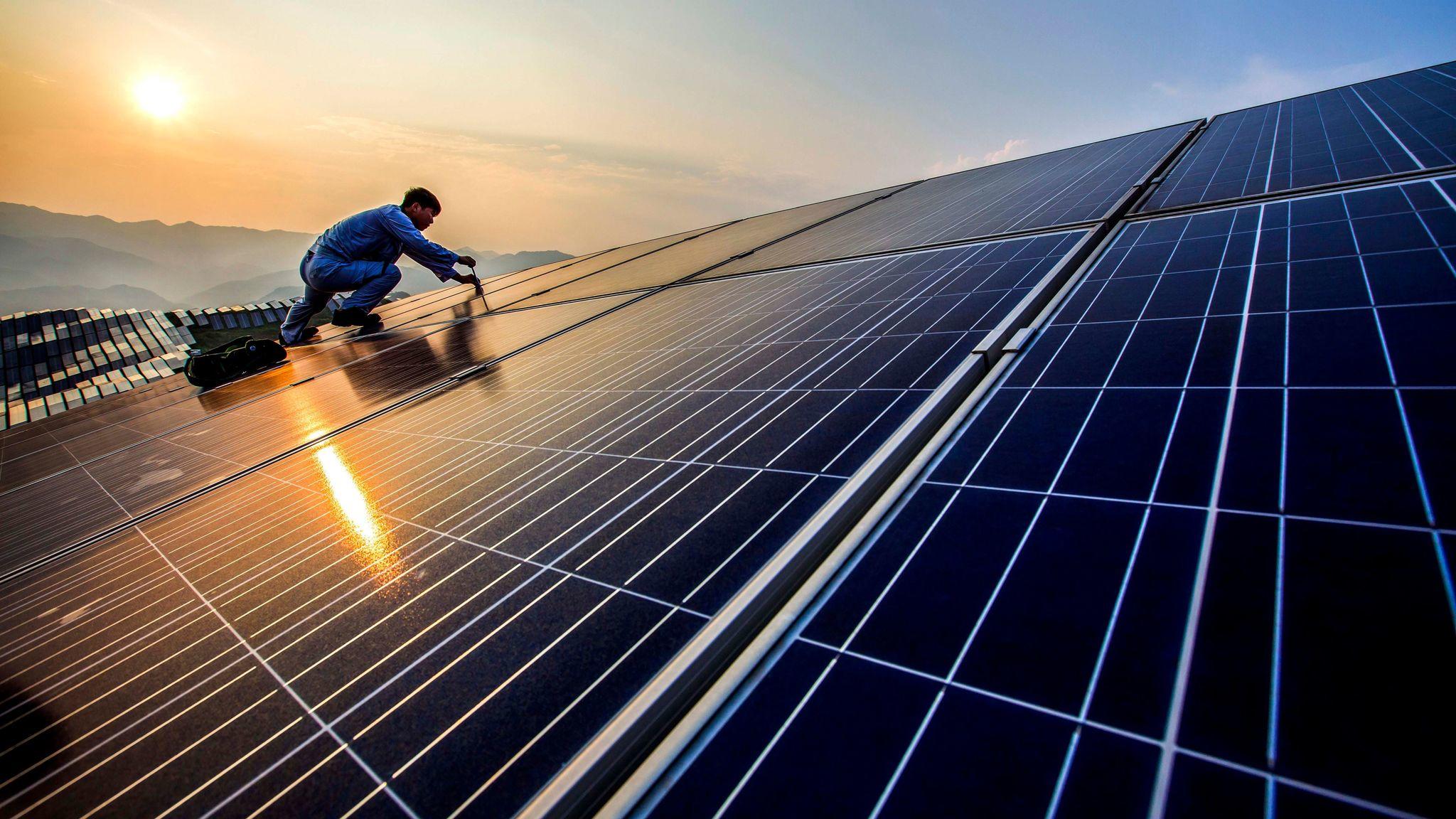
Over the past few years, significant changes have been observed in the electric power sector with the redirection of the electric power generation vector from traditional sources to renewable energy facilities. Such transformations pose serious challenges to specialists in ensuring the stability of the entire electric power system and search for effective methods of forecasting energy production from renewable energy facilities.
For a comprehensive solution to the existing problem, it is necessary to consider two main directions:
1. Increasing the efficiency and flexibility of the power system through the construction of maneuverable generation and energy storage.
2. Improving the quality of forecasting electricity generation by renewable energy facilities.
Currently, KEGOC JSC, as the operator of the National Grid, is balancing the production/consumption of electric energy. Taking into account the shortage of maneuverable sources of electric energy in the territory of the Republic of Kazakhstan, the resulting imbalances are covered at the expense of the National Grid of the Russian Federation, therefore it is necessary to build its own maneuverable capacities in the territory of the Republic of Kazakhstan. At the same time, the growth of renewable energy facilities can be considered as one of the reasons for the need for maneuverable capacities. The main factor is an increase in the reliability of the entire power system of the Republic of Kazakhstan, including in the event of technological disturbances at stations, as well as the possibility of purchasing services to compensate for deviations at power plants in Kazakhstan.
The issue of improving the quality of forecasts for the generation of electric energy by renewable energy facilities is becoming even more urgent.
Forecasting of the energy generated by renewable energy facilities shows the expected amount of energy generation at a certain point in time (annual, monthly, daily, hourly).
In particular, the availability of wind energy is significantly affected by fluctuations in meteorological conditions, including seasonal changes. That is why forecasting energy generation by renewable energy facilities, unlike traditional power plants, is an extremely complex process, often characterized by multiple uncertainty factors.
As mentioned above, the generation of electricity by renewable energy facilities is variable, since the amount of electricity generated by a wind power plant directly depends on the current wind speed at the site, and therefore the quality of the forecast for electricity generation is higher, the more accurate the forecast data on wind speed at the WPP site.
As an example, we can consider forecasting the generation of electric energy by a 100 MW wind power plant located in the Northern Zone of the Republic of Kazakhstan (the WPP).
The forecast for generation of electric energy of the wind power plant is carried out by various methods: independently by the station staff, using data on the projected wind speed based on data from open sources, interaction with the wind turbine manufacturer, as well as with the world's leading companies in the field of forecasting for the generation of electric energy (Figure 1).
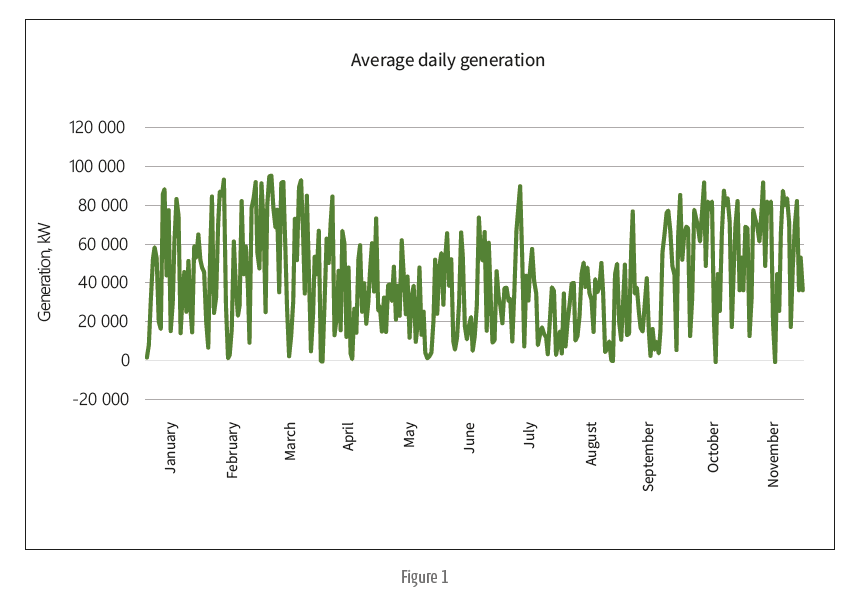
The graph below clearly reflects the work of the wind power plant on a daily basis during the year. During the day, the WPP reaches generation to the level of installed capacity and decreases to 0 MW.
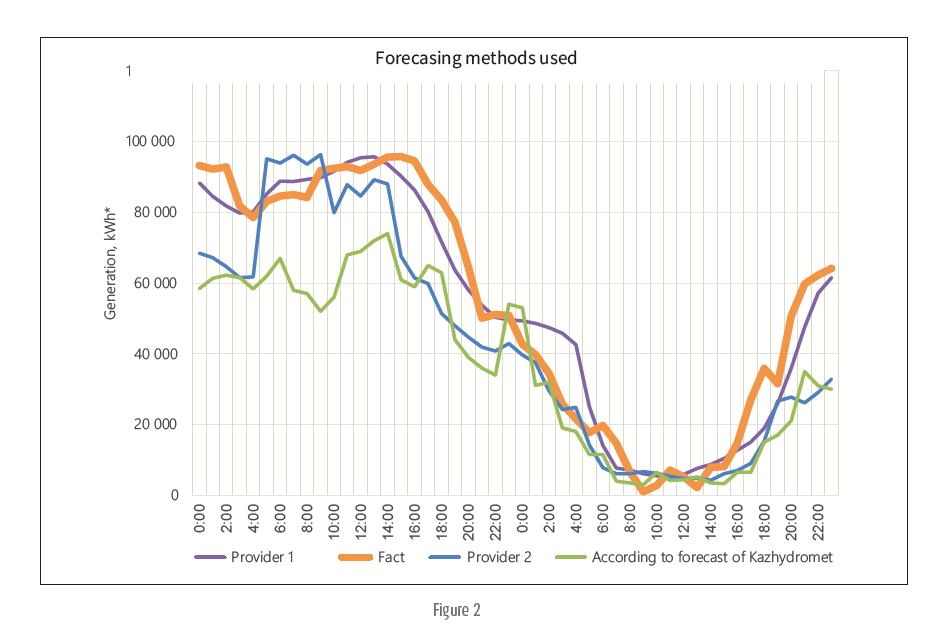
As is commonly known, the quality of forecasts for the generation of electric energy for longer periods of time is an order of magnitude higher than short-term, hourly. The Company manages to make forecasts for generation of electrical energy for long periods of time, for example, a year, a month and even a day, with minimal deviations, up to 10%. The graph below shows data on forecast and actual data on electricity generation in monthly/annual terms.
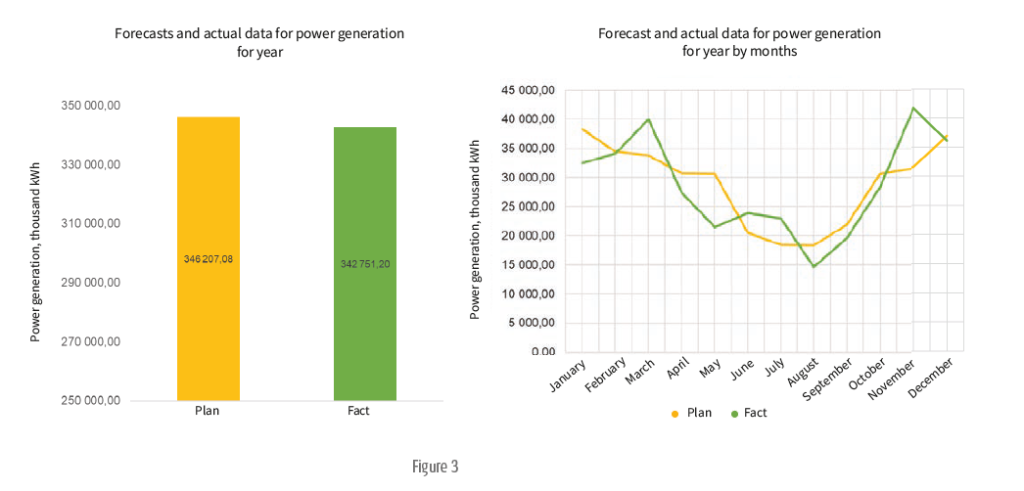
Considering forecasting in hourly terms, during the period of operation, both periods with a deviation close to 0% (Figure 4) and deviations reaching 1000% or more (Figure 5) are observed.
What factors contribute to such circumstances?
Wind turbines enter the nominal operating mode at a certain wind speed, usually at 11-12 m/s, respectively, the quality of forecast data will improve during a steady windy period of time (winter, autumn time periods).
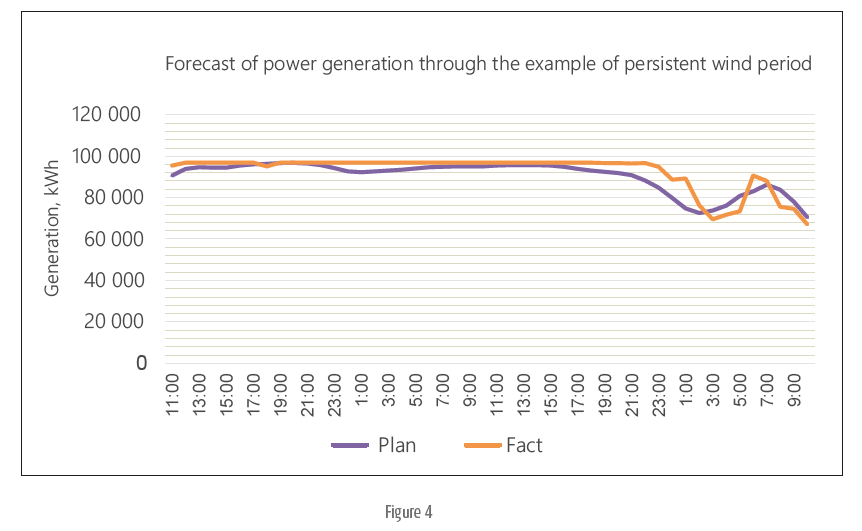
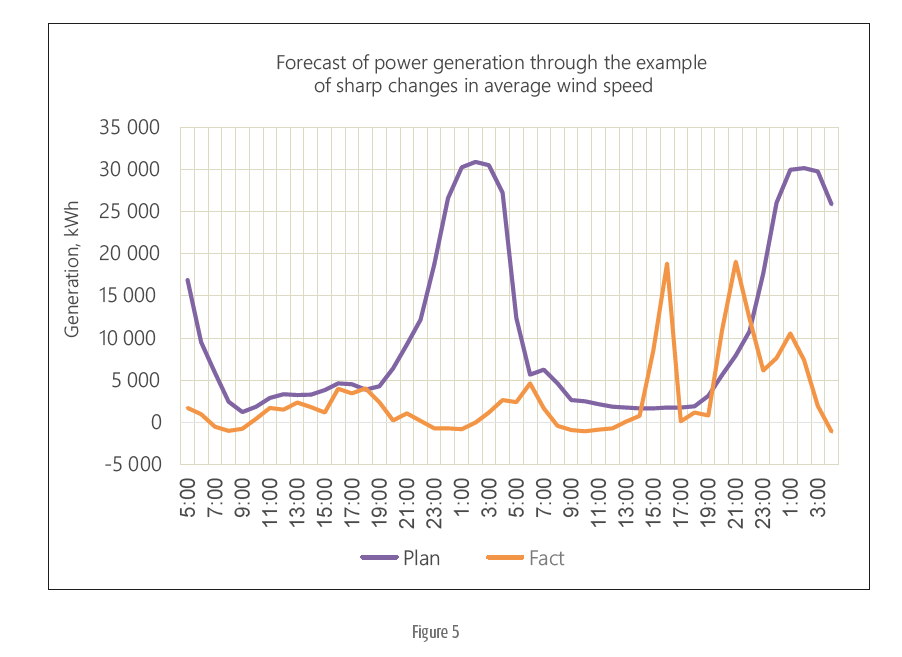
The main difficulty of forecasting electric energy in the territory of the Republic of Kazakhstan in comparison, for example, with Europe, is a sharply continental climate with characteristic significant amplitudes of daily and seasonal air temperatures. For example, in the spring and autumn periods on the territory of the wind power plant, wind speed differences at wind power plants can reach six meters or more. At the same time, the greatest distance between the turbines is only 10 kilometers. These factors contribute to huge differences between actual and forecast data in hourly terms.
In general, given the rather serious problems in the field of forecasting electricity generation by renewable energy facilities, a sharp transition to a balancing electricity market is expected to be very sensitive.
For example: the renewable energy players of European countries, including Spain[1], Denmark[2], Great Britain and Germany[3], several years ago switched to the model of the balancing electricity market proposed (from July 1 this year in Kazakhstan) by the authorized body and the system operator. However, in Europe, unlike our country, such a transition was achieved in stages and with significant differences.
Thus, during the evening and morning maximum, the tariff level from renewable energy facilities reaches 0.35 euro cents/kWh. In addition, renewable energy facilities are provided with tax and investment preferences, along with the sale of CO ₂ quotas at tariffs of 60 euros/ton in the current period with an increase to 170 euros/ton by 2035[4]. In addition, the maximum possible deviations from the forecast data have been established.
Based on the above, it can be summed up that the planned transition of renewable energy facilities to a balancing electricity market will entail a number of significant problems due to the almost lack of opportunity to achieve proper results in predicting the generation of electricity by renewable energy facilities. These factors will directly have an impact on the decline in the pace of renewable energy development, a decrease in investment attractiveness in this industry, which, accordingly, threatens the achievement of carbon neutrality by the Republic of Kazakhstan in the scheduled time.
The introduction of balancing market in real time proposed by the authorized body and the system operator is largely caused by the lack of sufficient maneuverable capacity, technological disruptions at traditional generation facilities and in the networks of energy transmission organizations. Accordingly, we can say that it is proposed to shift the solution of a number of long-overdue and existing problems in the country's energy system through the introduction of a balancing electricity market to the shoulders of renewable energy facilities that are not related to them.
To solve this problem, and also taking into account the experience of leading European countries, it is proposed to establish for existing renewable energy facilities and ongoing projects that have signed agreements with the settlement and financial center, the maximum value of permissible deviations between planned and actual values of electric power generation in the range of up to 10% per day (not per hour). In addition, it is necessary to consider the possibility of providing a test transition period to provide renewable energy facilities with the necessary technical, information and computing complexes.
Astana to host Electronica Expo Kazakhstan Electronics Exhibition
WB gives rundown of Azerbaijan's green energy grid volume prospects
US solar sets new records as renewables nearly match natural gas – EIA
‘Wings’ on poles: Bill Gates-backed breakthrough wind turbine facility breaks ground
Perovskite tandem solar cell achieves new efficiency record
Kazakhstan and China endorse draft SCO joint statement on sustainable energy development
Innovative research on organic solar cells for space applications
Kazakhstan and Uzbekistan drive green energy progress in Central Asia
KazMunayGas launches pilot green hydrogen project in Atyrau
How private homeowners in Kazakhstan can make money from solar panels
14 countries are investing in Kazakhstan's renewable energy sector through auctions
How green hydrogen could transform Kazakhstan’s energy sector
IKEA offers ready-to-use solar power systems for balconies
Adani commissions India’s first off-grid green hydrogen pilot plant
Tajikistan unveils green energy roadmap at international conference in Dushanbe
Hydropower projects selected through KOREM Auction in Kazakhstan
EU reaches political deal to simplify CBAM
New research could unlock the potential of bladeless wind turbines
Uzbekistan to launch 16 renewable energy facilities by the end of 2025
Kazakhstan holds auction for 50 MW of small hydropower projects











